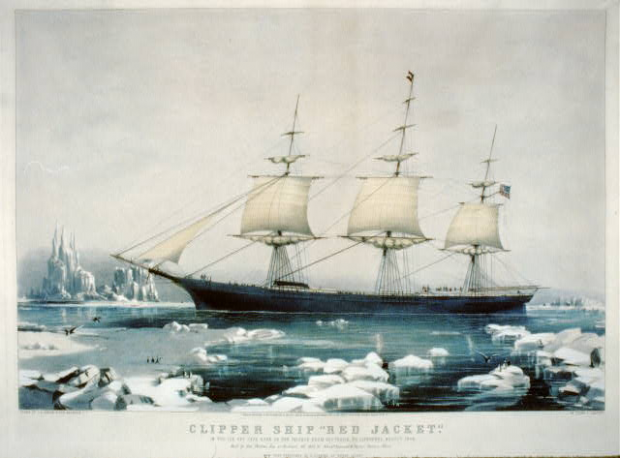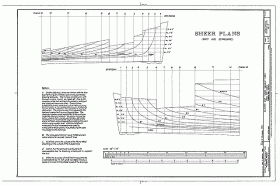Clippers were built in Maine in the 1850’s, with 54 having been constructed from 1851 to 1854. Depending on how you define “Clipper,” William Hutchinson Rowe counts ninety from 1850 to 1856. Since some very fast ships were known as “clippers,” regardless of some technical features, Rowe declares, “And so casting close definition and technical classification aside, we choose to tell the tale of the fast, sharp ships of the fifties . . . .”
Among them were Nightingale, Saratoga, Snow Squall, Spitfire, Red Jacket, and Flying Scud. Red Jacket, reputed to have been the fastest, was built in Rockland.
The Snow Squall was built in Cape Elizabeth at the Alford Butler shipyard in 1851. She made the New York-San Francisco trip in 155 days. But on March 1, 1864, she ran aground in the Straits of Le Marie in South America and was damaged beyond repair.
Snow Squall‘s bow survives today, under the supervision of the Maine Maritime Museum in Bath, as the sole remaining example of the hundreds of American-built clipper ships which made record-setting voyages carrying goods and passengers to and from Gold Rush-era California, Australia and the Far East. A clipper was very narrow in proportion to its length, which a sharp hollow bow; it was square-rigged, typically with an enormous spread of canvas. Vessels of this type developed in the 1840s, designed fro speed (rather than large cargo capacity) in a boom time of high freight rates. By the late 1850s, economic conditions favored slower ships of greater cargo capacity and smaller crews, so clipper construction was abandoned.
The romance of the clipper ship era remains in the public mind, yet little primary evidence survives to disclose details regarding American clipper design and construction practices. Snow Squall’s bow section thus represents a unique resource for both scholars and the general public. (Library of Congress catalog note.)
Many Maine yards where involved in building sailing ships of all sorts: barges, barks, brigantines, coasters, Down-Easters, and freighters, among others. With few exceptions, the clippers were the fastest.
Noonday was one of the eight clippers built in Kittery, all during the 1850s. Serving the demand of the California Gold Rush, it sank in San Francisco Bay in 1863. The wreck was lost for over 150 years until it was located in 2014 by researchers using a remote controlled submarine.
Clippers were built in twenty-seven towns from Kittery to Eastport and beyond: Kittery, Eliot, Kennebunk, Cape Elizabeth, Cumberland, Freeport, Brunswick, Bath, Richmond, Farmingdale, Hallowell, Pittston, Alna, Newcastle, Damariscotta, Bristol, Waldoboro, Thomaston, Warren, Rockland, Belfast, Orland, Frankfort, Trescott, Eastport, Pembroke and Robbinston.
Additional resources
Baker, William Avery. A Maritime History of Bath, Maine and the Kennebec River Region. Bath, Me. Marine Research Society of Bath. 1973.
Bryant, S.E. A List of Vessels Built from 1800 to 1878 [with a supplement from 1874 to 1884]. Kennebunk, Me. Brick Store Museum. 1950.
Snow Squall plans image from “Clipper Ship SNOW SQUALL Bow, Spring Point Museum, Southern Maine Technical College, South Portland, Cumberland, ME” Library of Congress. Prints & Photographs Online Catalog. At http://www.loc.gov/pictures/item/ME0230/.
Dean, Nicholas. Snow Squall: The Last American Clipper Ship. Gardiner, ME. Tilbury House, 2001.
“Red Jacket” image from Library of Congress. Prints & Photographs Online Catalog. At http://www.loc.gov/pictures/item/90716151/. Reproduction Number: LC-DIG-pga-03627 (digital file from original print)
Rowe, William Hutchinson. Shipbuilding Days and Tales of the Sea, In Old North Yarmouth and Yarmouth, Maine. Portland, Me. Marks Printing House. 1924.
Rowe, William Hutchinson. The Maritime History of Maine: Three Centuries of Ship Building and Seafaring. W.W. Norton. 1948. Reprinted: Gardiner, Me. Harpswell Press. 1989. Quote from p. 167.




Hi there folks,
I am doing some research for a novel I am writing about one of my seafaring ancestors.
In 1858 he shipped on a clipper named the Arey in Norfolk. A crew was required to man the vessel which was being towed to Baltimore by the USS Wabash. Apparently the captain and the first mate had murdered a number of the crew of the previous voyage and were being taken to Baltimore for trial.
I have some details of the Arey, eg: she was built by James Arey and Sons in Frankfort, and launched in 1856.
What I cant find are any details of her voyages, in particular the one in which the crewmen were murdered.
If there is anyone out there who has heard of the Arey, or knows where I can find more information about her voyages between 1856 and 1858?
Hoping you can help,
Regards
Graham Franklin-Browne
Karabar
NSW
Australia
Juiiann sent this note: I read a letter that was sent to my great, great grandfather who’s last name was Dunning from Bangor Maine. He was a merchant and had ships built in Maine that traveled around the world. The letter was from a Captain who had taken his ship on the rocks some where off the coast of Australia . It was many years ago that I read this letter …my family tells me there is no such letter but, I remember reading it. The name of the ship was The Rocket. Is there any one who could direct me in the correct direction to track down this Clipper or Schooner built by the Dunning Family in Maine?? I am so curious about my family history.
Juliann Wickliffe
julie.wickliffe@gmail.com